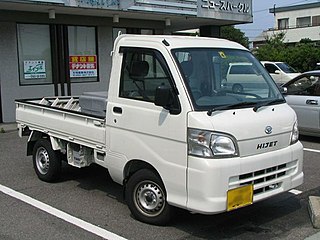
Kei car is the Japanese vehicle category for the smallest highway-legal passenger cars. Similar Japanese categories exist for microvans, and Kei trucks.
Visual kei is a movement among Japanese musicians, that is characterized by the use of varying levels of make-up, elaborate hair styles and flamboyant costumes, often, but not always, coupled with androgynous aesthetics, similar to Western glam rock.

Shibuya-kei is a microgenre of pop music or a general aesthetic that flourished in the mid to late 1990s. Emerging as Japanese retail music from the Shibuya district of Tokyo, artists purveyed a cut-and-paste style that was inspired by previous genres based on kitsch, fusion, and artifice. Shibuya-kei inherited musical characteristics from earlier 1980s Japanese city pop, while incorporating strong influences from 1960s culture and Western pop music, especially the orchestral domains occupied by producers Burt Bacharach, Brian Wilson, Phil Spector, and singer Serge Gainsbourg.

The Mitsubishi Minica is a kei car produced by Mitsubishi Motors (MMC) mainly for the Japanese domestic market from 1962 to 2011. It was first built by Shin Mitsubishi Heavy-Industries, one of Mitsubishi Heavy Industries' three regional automotive companies until they were merged in 1964, and as such predates MMC itself. In Japan, it was sold at a specific retail chain called Galant Shop. In 2011, the car was replaced with the Mitsubishi eK.

The Honda Today was a kei car (minivehicle) produced by the Japanese automaker Honda beginning in 1985. It was replaced by the Honda Life in 1998. Honda's smallest car being produced at the time was the Honda City, which was a supermini and it had an engine larger than kei car legislation allowed. The Today represented a re-entry into kei car production. Honda had abandoned kei passenger cars in 1975, choosing to manufacture the Honda Acty kei truck, and the Honda Street microvan for that segment. Previously, Honda's smallest car was the Honda Civic, followed by the smaller Honda City in 1981.

The Daihatsu Hijet is a cabover microvan and pickup truck produced and sold by the Japanese automaker Daihatsu since 1960. Despite the similarities between the Hijet name and Toyota's naming scheme for its trucks and vans, the name "Hijet" has been in use for Daihatsu's Kei trucks and Microvans since 1960, over two decades before Toyota took control. "Hijet", when transliterated into Japanese, is very similar to "Midget", one of Daihatsu's other mini-trucks. The Hijet competes in Japan with the Honda Acty, Subaru Sambar, Mitsubishi Minicab, Suzuki Carry and the Nissan Clipper.

Super Dimension Century Orguss is an anime science fiction series. It inspired an OVA sequel series called Orguss 02. Orguss was the second part of The Super Dimension trilogy from Big West, preceded by The Super Dimension Fortress Macross and followed by The Super Dimension Cavalry Southern Cross.

The Honda Acty is a series of cabover microvans and kei trucks produced by the Japanese automaker Honda since 1977, designed for the Japanese domestic market (JDM). "Acty" is short for "Activity".

The Honda Life was a name that was used on various kei car/city cars produced by Honda: passenger cars, microvans, and kei trucks. The first series of the nameplate was built between 1971 and 1974, with the name revived in 1997. The Honda Life has rarely been marketed outside Japan.

The Subaru Sambar is a cabover kei truck and microvan manufactured by Subaru, a division of Fuji Heavy Industries, specifically for the Japanese market. It is Japan's first Keitora (軽トラ), shorthand for "kei class truck" and is still in production. The Sambar is available in both microvan and Kei truck to fulfill the Kei car guidelines. Still popular in the domestic market, the Sambar continues to be produced in Japan, China as well as in Finland with a joint venture with Elcat Automotive.

A microvan is a van or minivan that fits into Japanese kei car classification or similar, and is smaller than a mini MPV.

A Kei truck, or Kei class truck, or Japanese mini truck is a mini truck, a tiny but practical pickup truck available in RWD or 4WD version, built to satisfy the Japanese keijidōsha statutory class. They are known as Keitora in Japan alongside the microvan.

The Tiger Truck is a light utility truck sub-brand from Chinese manufacturer Chang'an. It belongs to a class of vehicles known as “mini-trucks,” “micro trucks,” “K trucks,” and "kei trucks”. The K is short for kei jidosha, Japanese for “light vehicle” and the name of a special class of vehicles subject to reduced taxation in Japan. In the United States, this class of vehicle is classified as a low speed vehicle as defined under CFR 49-571.500 and is limited to a top speed of 25 MPH. As such, it is only legal for off highway use and/or local road use.
The Kei–Tanimbar languages are a small group of Austronesian languages spoken on the Kei and Tanimbar islands in the southern Maluku Islands, and on the north side of the Bomberai Peninsula. The languages are:
Keiese is an Austronesian language spoken in a small region of the Moluccas, a province of Indonesia.
Stiaan van Zyl is a South African cricketer who plays for Sussex County Cricket Club as a left-handed batsman who bowls right-arm medium pace.

The Daihatsu Wake is a kei car with sliding doors manufactured by the Japanese automaker Daihatsu. The design was previewed by Deca Deca concept cars that were shown at 2009 and 2013 Tokyo Motor Show respectively. It went on sale on 10 November 2014. It has interior cabin height of 1,455 mm (57.3 in), which is highest in the kei car class. It also has a claimed mileage of 25.4 km/L. Toyota also sold the Wake as the Toyota Pixis Mega. The van version of the Wake is called the Hijet Caddie. The Hijet Caddie has a permitted maximum loading capacity of 150 kg (331 lb).
The 2016 Liga de Elite began on 15 January 2016 and ended on 12 June 2016.















